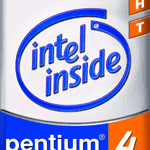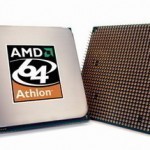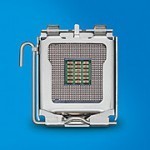Socket 754 is a 754-contact CPU socket used by some AMD Athlon and Sempron processors. Socket-754 supports a 200MHz system clock and an 800Mhz HyperTransport link. Socket-754 is similar to Socket-939, except that Socket-754 supports only one memory controller channel as opposed to the dual channels available on the Socket-939 and that the HyperTransport bus is 800MHz as opposed to 1000Mhz. The Socket-754 is a Pin Grid Array (PGA) Zero Insertion Force (ZIF) socket. A ZIF socket features a lever on one side of the socket. When this lever is Read More
Front Side Bus
The Front Side Bus (FSB) is the connecting path between the CPU and other key components such as system memory. The Front Side Bus is also called the Data Bus and the Processor Side Bus (PSB). Front Side Bus Widths of Various CPUs CPU Front Side Bus Width 8088 8 8086 16 80286 16 80386SX 16 80386DX 32 80486 32 AMD 5×86 32 Pentium 64 AMD K6 64 Pentium Pro 64 Celeron 64 Pentium II 64 Pentium III 64 AMD Duron 64 AMD Athlon 64 AMD Athlon XP 64 Pentium Read More
How to Upgrade a CPU
You can upgrade an older microprocessor to a newer one in easy steps. Before going ahead, you should gather information about which new CPU you need and whether your motherboard is compatible with it or not. The compatibility of your new CPU with your motherboard can be ascertained by searching for specific information on the Internet, or checking with your trusted computer dealer. Preparing to Upgrade to a New CPU After purchasing the correct new CPU, make sure that adequate grounding is available before starting to replace the old CPU. Read More
Hyper-Threading

Hyper-Threading technology is a technique that enables a single CPU to act like multiple CPUs. A CPU is made up of many smaller components. At any given time, one of these components might be busy, while the other components are waiting to be utilized. Hyper-Threading enables different CPU parts to work on different tasks concurrently. In this way, a CPU with Hyper-Threading appears to be more than one CPU. A CPU with Hyper-Threading has two sets of the circuits that keep track of the CPU’s state. This includes most of Read More
Athlon-64

Athlon-64 is a name for AMD’s main line of 64-bit CPUs. The Athlon-64 line is designed to complete against the Intel Pentium CPUs. Athlon-64 processors are designed to execute 32-bit and 64-bit instructions simultaneously. This enables them to directly address more than 4GB of RAM. Athlon-64 CPUs feature an L1 cache with 64KB of RAM for data and 64KB of RAM for instructions. The 1024KB L2 cache in an Athlon-64 CPU operates at the full speed of the CPU. These L1 and L2 cache numbers are per core. In a Read More
LGA-775

LGA-775 is a 775-contact CPU socket used by some Intel Celeron D, Pentium D, Pentium Extreme Edition, Pentium 4, and Pentium 4 Extreme Edition processors. LGA stands for “Land Grid Array”. In English, this means that the pins in an LGA socket are built into the socket — not into the CPU. This total reversal of earlier designs gives better power distribution, which enables Front Side Bus speeds up to 266MHz. Moving the fragile pins from the CPU to the motherboard also means that if you break a pin, you Read More
SSE (Streaming SIMD Extensions)
SSE stands for Streaming SIMD Extensions. Introduced by Intel in its line of Pentium III processors, SIMD technology allows for "Single Instruction Multiple Data." While older processors could only process one data element per instruction, SIMD technology allows instructions to handle multiple data elements, making processing much quicker. SSE's use of SIMD technology allows for data processing in applications such as 3D graphics to benefit greatly from the use of SSE. In contrast to MMX, a fairly similar technology, SSE registers have much larger bits, allowing SSE to work even Read More
MMX (Multimedia Extensions)
MMX stands for Multimedia Extensions. MMX is a technology designed to accelerate multimedia and communications applications. This acceleration and simplification is done through a set of multimedia instructions which are built into microprocessors to enable them to handle common multimedia operations like DSP, or Digital Signal Processing. MMX works by taking certain operations, such as moving a pixel of graphics, which are usually processed as 8-bit integers, and instead packing a number of these pixels into one larger data unit. MMX then performs the requested operation on the larger data Read More
Athlon
Athlon is a name for AMD’s main line of Intel-compatible CPUs. The Athlon line is designed to complete against the Intel Pentium CPUs. Athlon CPUs feature a L1 cache with 64KB of memory for data and another 64KB of memory for instructions. Athlon CPUs support MMX, 3DNow!, and SSE. Some models of Athlon CPUs also support SSE2. Athlon CPUs are designed to fit Socket-A or Socket-754 CPU sockets. Athlon CPUs are slowly being phased out in favor of the newer Athlon 64 family of CPUs.
AMD64
AMD64 is a set of 64-bit extensions to AMD x86-compatible microprocessors. AMD64 extends the industry-standard x86 instruction set architecture while maintaining full compatibility with existing x86 applications. The 64-bit architecture of AMD64 enables applications to utilize up to 256 terabytes of memory, overcoming the 4 gigabytes limitation of 32-bit processors. AMD64 doubles the number of general purpose registers to 16 and doubles their size to 64-bits. AMD64 also doubles the number of 128-bit XMM registers to 16. AMD64 includes support for SSE and SSE2 instructions. Later releases of AMD64 add Read More


Share on: